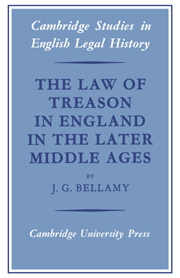Book contents
- Frontmatter
- Contents
- Editor's Preface
- Preface
- List of Abbreviations
- 1 The Medieval Concept of Treason
- 2 The Treatise Writers and the English Law of Treason at the End of the Thirteenth Century
- 3 The Origins of the English State Trial
- 4 The Great Statute of Treasons
- 5 The Scope of Treason, 1352–1485
- 6 Treason before the Courts, 1352–1485
- 7 The Origins and the Early History of the Act of Attainder
- 8 Treason and the Constitution
- Appendixes
- Select Bibliography
- Index
4 - The Great Statute of Treasons
Published online by Cambridge University Press: 14 October 2009
- Frontmatter
- Contents
- Editor's Preface
- Preface
- List of Abbreviations
- 1 The Medieval Concept of Treason
- 2 The Treatise Writers and the English Law of Treason at the End of the Thirteenth Century
- 3 The Origins of the English State Trial
- 4 The Great Statute of Treasons
- 5 The Scope of Treason, 1352–1485
- 6 Treason before the Courts, 1352–1485
- 7 The Origins and the Early History of the Act of Attainder
- 8 Treason and the Constitution
- Appendixes
- Select Bibliography
- Index
Summary
Perhaps no English statute of the later middle ages has yielded its secrets more reluctantly to the historian than the treason act of 1352. There have been at least as many opinions as commentators, probably more, since some criticisms have not even had the merit of consistency. To a large extent this unsatisfactory state arose because of the scarcity of evidence concerning executive action on matters of treason in the decades which preceded and followed the statute's promulgation. There seemed, so to speak, no controls to test a theory against. The executions of important men just before and after the deposition of Edward II were almost the same distance in time from the treason statute as the impeachments in the Good Parliament. In 1352 Edward III was a hero with both the baronage and the commonalty and there was very little likelihood of treasonable crimes being committed in such numbers and of such variety that the exact intention of the statute would be displayed in trial and sentence. On the whole historians have concluded that Edward's design was either legal or political, the advocates of each type of motivation being fairly equally divided. Thus Miss McKisack states that ‘the primary object of the statute was probably legal rather than political; to establish a clear distinction between high and petty treason and so to settle the rules about forfeitures’. Plucknett's views are very similar: ‘the motives of the statute are patently to prevent the loss of escheats by treating felonies of certain sorts as treason.
- Type
- Chapter
- Information
- The Law of Treason in England in the Later Middle Ages , pp. 59 - 101Publisher: Cambridge University PressPrint publication year: 1970



